3D printing materials manufacturer Nanovia specializes in the production of filaments for industrial additive manufacturing and distributes numerous polymers, including carbon fiber reinforced polypropylene (PP CF). The unique properties of this material are used by Athletics 3D to produce custom accessories for rifles, shotguns and shooting pistols for biathlon.
Polypropylene (PP) is thermoplastic polymer developed in the 1950‘s. It has three distinct variants (atatic, isotactic, and syndiotactic) with different mechanical and thermal properties.
PP is one of the most used plastic after polyethylene (PE), due to wide and universal applications, mainly in industrial settings, thanks to its toughness and lightness.
A “flexible” polymer
PP has most of the signs of a flexible material. We mainly know it in its amorphous state at room temperature. Meaning that its polymer chain is unstructured. PP’s glass transition temperature is negative, around -4 and -18°C depending on the variant.
Mechanical properties suited for industrial use
With the very low density of 1g/cm3, PP is the go to material of the automotive sector, it’s used for plastic injected body works, bumpers and rear view mirrors.
PP is non toxic and does not have a smell hence why it is also widely used in the food industry for feeding and reusable bottles as well as various packagings. A typical example of the use of PP, was up to recently plastic straws thanks to its high wear resistance to repeated deformations.
As with all thermoplastics, PP can be recycled, and currently is in France.
A high chemical resistance
It’s impermeable nature and resistance to most organic solvents make it a widely used material in the pharmaceutical industry, notably for piping and containers for agressive chemicals and laboratory accessories.
PP has a very low surface tension, making it resistant to most glues, this makes its use in additive fabrication tougher than other materials. To be “glued” it needs to be hot welded.
A material adapted for a wide range of temperatures
When used at high temperatures PP’s mechanical properties will slowly decline, unlike other polymers that fail abruptly. It’s dishwasher safe and often used for reusable plates and cutlery.
PP is not affected by humidity, and resists low temperatures. This makes it than when used in sub zero situation no ice crystals form inside of the material.
These properties make PP usable on a temperature scale of -20°C up to 120°C.
PP’s water resistance makes it a material that does not swell in humid environments staying the same volume and density, unlike the comparable in properties polyamide (PA).
PP is relatively flexible, and can be deformed by around 200% before tearing.
Why add carbon fibres to polypropylene?
During the 3D printing process with fused filaments (FFF), PP is extruded at 260°C, heated materials expand, and when they cool back down shrink back to their original size. This shrinking back can cause the material to unstick from the 3D printer’s base plate. When unstuck, the part will deform or even completely fail the print. This phenonomen is called warping. Adding fibres counters this effect and hold the material in place.
Adding fibres also vastly increased the material’s rigidity. Whereas native PP can stretch up to 200% carbon fibre PP only stretched 2 to 3%
Whilst increasing the rigidity it also increases the ultimate material strength, meaning it can withstand more stress before yielding. Nanovia PETG GF (glass fibre reinforced) for example, is 40% more resistant than native PETG.
Furthermore, while native PP is sensitive to UV radiation, carbon fibres absorb them. This makes Nanovia PP CF ideal for any object with an outdoor usage.
A plastic reserved for technical printing
3D printing PP requires a specialized set-up making the material challenging to work with.
- A PP based build plate, to “weld” the material to. This can also be a film that is applied to a normal build plate.
- A build plate with micro perforations for the material to anchor itself into.
- Specialized adhesives.
Find out more about Athletics 3D at athletics3d.com.
For more information about Nanovia, please visit nanovia.tech.
Subscribe to our Newsletter
3DPresso is a weekly newsletter that links to the most exciting global stories from the 3D printing and additive manufacturing industry.





















